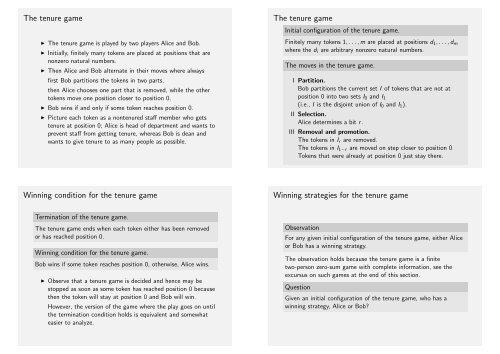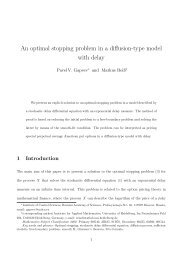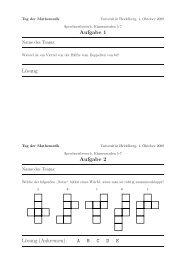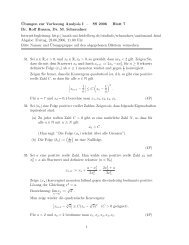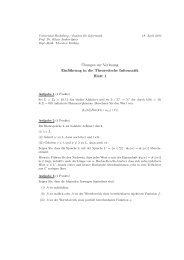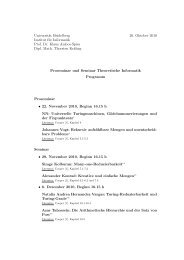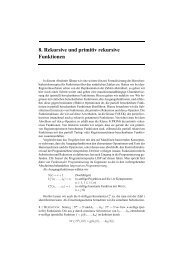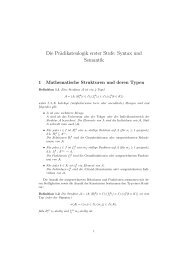The tenure game The tenure game Winning condition for the tenure ...
The tenure game The tenure game Winning condition for the tenure ...
The tenure game The tenure game Winning condition for the tenure ...
You also want an ePaper? Increase the reach of your titles
YUMPU automatically turns print PDFs into web optimized ePapers that Google loves.
<strong>The</strong> <strong>tenure</strong> <strong>game</strong><br />
◮ <strong>The</strong> <strong>tenure</strong> <strong>game</strong> is played by two players Alice and Bob.<br />
◮ Initially, finitely many tokens are placed at positions that are<br />
nonzero natural numbers.<br />
◮ <strong>The</strong>n Alice and Bob alternate in <strong>the</strong>ir moves where always<br />
first Bob partitions <strong>the</strong> tokens in two parts,<br />
<strong>the</strong>n Alice chooses one part that is removed, while <strong>the</strong> o<strong>the</strong>r<br />
tokens move one position closer to position 0.<br />
◮ Bob wins if and only if some token reaches position 0.<br />
◮ Picture each token as a non<strong>tenure</strong>d staff member who gets<br />
<strong>tenure</strong> at position 0; Alice is head of department and wants to<br />
prevent staff from getting <strong>tenure</strong>, whereas Bob is dean and<br />
wants to give <strong>tenure</strong> to as many people as possible.<br />
<strong>Winning</strong> <strong>condition</strong> <strong>for</strong> <strong>the</strong> <strong>tenure</strong> <strong>game</strong><br />
Termination of <strong>the</strong> <strong>tenure</strong> <strong>game</strong>.<br />
<strong>The</strong> <strong>tenure</strong> <strong>game</strong> ends when each token ei<strong>the</strong>r has been removed<br />
or has reached position 0.<br />
<strong>Winning</strong> <strong>condition</strong> <strong>for</strong> <strong>the</strong> <strong>tenure</strong> <strong>game</strong>.<br />
Bob wins if some token reaches position 0, o<strong>the</strong>rwise, Alice wins.<br />
◮ Observe that a <strong>tenure</strong> <strong>game</strong> is decided and hence may be<br />
stopped as soon as some token has reached position 0 because<br />
<strong>the</strong>n <strong>the</strong> token will stay at position 0 and Bob will win.<br />
However, <strong>the</strong> version of <strong>the</strong> <strong>game</strong> where <strong>the</strong> play goes on until<br />
<strong>the</strong> termination <strong>condition</strong> holds is equivalent and somewhat<br />
easier to analyze.<br />
<strong>The</strong> <strong>tenure</strong> <strong>game</strong><br />
Initial configuration of <strong>the</strong> <strong>tenure</strong> <strong>game</strong>.<br />
Finitely many tokens 1, . . . , m are placed at positions d1, . . . , dm<br />
where <strong>the</strong> di are arbitrary nonzero natural numbers.<br />
<strong>The</strong> moves in <strong>the</strong> <strong>tenure</strong> <strong>game</strong>.<br />
I Partition.<br />
Bob partitions <strong>the</strong> current set I of tokens that are not at<br />
position 0 into two sets I0 and I1<br />
(i.e., I is <strong>the</strong> disjoint union of I0 and I1).<br />
II Selection.<br />
Alice determines a bit r.<br />
III Removal and promotion.<br />
<strong>The</strong> tokens in Ir are removed.<br />
<strong>The</strong> tokens in I1−r are moved on step closer to position 0<br />
Tokens that were already at position 0 just stay <strong>the</strong>re.<br />
<strong>Winning</strong> strategies <strong>for</strong> <strong>the</strong> <strong>tenure</strong> <strong>game</strong><br />
Observation<br />
For any given initial configuration of <strong>the</strong> <strong>tenure</strong> <strong>game</strong>, ei<strong>the</strong>r Alice<br />
or Bob has a winning strategy.<br />
<strong>The</strong> observation holds because <strong>the</strong> <strong>tenure</strong> <strong>game</strong> is a finite<br />
two-person zero-sum <strong>game</strong> with complete in<strong>for</strong>mation, see <strong>the</strong><br />
excursus on such <strong>game</strong>s at <strong>the</strong> end of this section.<br />
Question<br />
Given an initial configuration of <strong>the</strong> <strong>tenure</strong> <strong>game</strong>, who has a<br />
winning strategy, Alice or Bob?
Games that Alice win and <strong>game</strong>s that Bob win<br />
Examples of initial configurations <strong>for</strong> <strong>the</strong> <strong>tenure</strong> <strong>game</strong>.<br />
(i) 2 k -1 tokens at position k.<br />
(ii) 2 k tokens at position k.<br />
(iii) One token at each position 1 through k.<br />
(iv) One token at each position 1 through k − 1<br />
and two tokens at position k.<br />
(v) Two tokens at each position 2 through k.<br />
(vi) Two tokens at each position 2 through k − 1<br />
and four tokens at position k.<br />
It is not so hard to see that <strong>the</strong> odd-numbered configurations are<br />
winning <strong>for</strong> Alice and <strong>the</strong> o<strong>the</strong>r configurations are winning <strong>for</strong> Bob.<br />
Question<br />
What is <strong>the</strong> general pattern?<br />
<strong>Winning</strong> configurations <strong>for</strong> Alice<br />
◮ Consider <strong>the</strong> <strong>tenure</strong> <strong>game</strong> where initially tokens 1, . . . , m are<br />
placed at positions d1, . . . , dm, respectively.<br />
◮ Fix any strategy <strong>for</strong> Bob.<br />
Assume Alice plays <strong>the</strong> randomized strategy.<br />
◮ Define indicator variables X1, . . . , Xm where Xi is 1 if and only<br />
if token i reaches position 0.<br />
Let X = X1 + . . . + Xm be <strong>the</strong> number of tokens that reach<br />
<strong>the</strong> origin.<br />
◮ <strong>The</strong> expectation of X is<br />
E [X ] = E [X1+· · ·+Xm] = E [X1]+· · ·+E [Xm] = 1 1<br />
+· · ·+ .<br />
d1 dm 2 2<br />
For any configuration with m tokens at positions d1, . . . , dm,<br />
we call 1<br />
2 d 1<br />
1 + · · · + 2dm <strong>the</strong> potential of <strong>the</strong> configuration.<br />
<strong>Winning</strong> configurations <strong>for</strong> Alice<br />
A randomized strategy <strong>for</strong> Alice<br />
Alice determines each bit r by tossing of a fair coin.<br />
No matter what <strong>the</strong> strategy of Bob is and how Bob partitions,<br />
when Alice plays <strong>the</strong> randomized strategy, <strong>the</strong>n<br />
each time Alice selects, any single token will be removed or<br />
promoted with equal probabilities of 1/2.<br />
Fur<strong>the</strong>rmore, since <strong>the</strong> coin tosses are independent, a token<br />
that is initially at position d, will reach position 0 with<br />
probabilty 1/2 d .<br />
<strong>Winning</strong> configurations <strong>for</strong> Alice<br />
◮ Consider a <strong>tenure</strong> <strong>game</strong> where <strong>the</strong> potential 1<br />
2d1 <strong>the</strong> intial configuration is strictly less than 1.<br />
1 + · · · + 2dm of<br />
◮ In this situation, also E [X ], <strong>the</strong> expected number of tokens<br />
that reach position 0, is strictly less than 1<br />
Hence <strong>the</strong>re must be some sequence of coin tosses<br />
where X < 1, i.e., such that no token reaches position 0.<br />
This means that <strong>the</strong>re is a sequence of coin tosses such that<br />
Alice wins.<br />
◮ <strong>The</strong> argument above does not depend on Bob’s strategy.<br />
That is, no matter what <strong>the</strong> strategy of Bob is, Alice can win.<br />
As a consequence, Bob cannot have a winning strategy.<br />
But <strong>the</strong>n Alice must have a winning strategy.
<strong>Winning</strong> strategy <strong>for</strong> Alice<br />
Proposition<br />
If <strong>the</strong> potential of <strong>the</strong> initial configuration is strictly less than 1,<br />
<strong>the</strong>n Alice has a winning strategy.<br />
◮ How does <strong>the</strong> winning strategy according to <strong>the</strong> proposition<br />
look like?<br />
◮ A terminal configuration is a configuration where all tokens<br />
are at position 0.<br />
<strong>The</strong> potential of a terminal configuration is equal to <strong>the</strong><br />
number of its tokens<br />
Observation<br />
A terminal configuration is winning <strong>for</strong> Alice if and only if <strong>the</strong><br />
potential of <strong>the</strong> configuration is strictly less than 1.<br />
◮ Idea <strong>for</strong> a strategy: Alice tries to maintain <strong>the</strong> invariant that<br />
<strong>the</strong> potential of <strong>the</strong> current situation is strictly less than 1.<br />
<strong>Winning</strong> strategy <strong>for</strong> Bob<br />
◮ What’s about initial configurations with potential of 1 or<br />
more?<br />
Observation<br />
A terminal configuration is winning <strong>for</strong> Bob if and only if <strong>the</strong><br />
potential of <strong>the</strong> configuration is at least 1.<br />
◮ Bob wins if he can maintain <strong>the</strong> invariant that <strong>the</strong> potential is<br />
at least 1.<br />
◮ Suppose Bob partitions <strong>the</strong> set of current tokens into sets I0<br />
and I1 where both correspond to a potential of at least 1/2.<br />
<strong>The</strong>n <strong>the</strong> subsequent promotion step ensures that <strong>the</strong><br />
potential will be at least 1 again.<br />
Strategy <strong>for</strong> Bob<br />
Partition <strong>the</strong> set of current tokens into sets I0 and I1 such that<br />
both sets correspond to a potential of at least 1/2.<br />
<strong>Winning</strong> strategy <strong>for</strong> Alice<br />
◮ If <strong>the</strong> initial configuration has potential strictly less than 1,<br />
<strong>the</strong>n Alice can maintain this property by <strong>the</strong> following strategy.<br />
Strategy <strong>for</strong> Alice<br />
Choose r such that when comparing <strong>the</strong> potentials of <strong>the</strong> two<br />
configurations that correspond to I0 and I1, <strong>the</strong> potential that<br />
corresponds to Ir is higher.<br />
◮ Assume that no token has yet reached position 0, and consider<br />
<strong>the</strong> partition of <strong>the</strong> set I of current tokens into I0 and I1.<br />
If we let p, p0, and p1 be equal to <strong>the</strong> potentials that<br />
correspond to I , I0 and I1, respectively, we have p = p0 + p1.<br />
◮ After <strong>the</strong> tokens in I1−r have been promoted, <strong>the</strong> potential of<br />
<strong>the</strong> new configuration is 2pr−1.<br />
By choice of r we have 2pr−1 ≤ p0 + p1 = p.<br />
Bob can partition equally<br />
◮ By <strong>the</strong> following lemma, <strong>the</strong> strategy <strong>for</strong> Bob is feasible .<br />
Lemma<br />
Let d1 ≤ . . . ≤ dm be a nondecreasing sequence of nonzero natural<br />
numbers where 1<br />
2d 1 1<br />
+ · · · + 1 2dm ≥ 2 . <strong>The</strong>n <strong>the</strong>re is an index t such<br />
that<br />
1 1 1<br />
+ · · · + = d1 dt 2 2 2 .<br />
Proof.<br />
◮ By assumption on <strong>the</strong> di, let t be minimum such<br />
that st = 1<br />
1 + · · · + dt<br />
1 ≥ 2 .<br />
2d1 2<br />
◮ In case st = 1/2 we are done.<br />
O<strong>the</strong>rwise, st and 1/2 are both multiples of 1<br />
2<br />
less than 1<br />
2dt , a contradiction.<br />
dt but differ by
Excursus on <strong>game</strong> <strong>the</strong>ory<br />
In a finite two-person <strong>game</strong> with perfect in<strong>for</strong>mation<br />
two players alternate in specifying moves,<br />
<strong>the</strong> player whose turn it is to specify <strong>the</strong> next move knows <strong>the</strong><br />
sequence of previous moves,<br />
<strong>the</strong>re are always at most finitely many possible moves,<br />
any admissible sequence of <strong>game</strong>s ends after a finite number<br />
of steps with one player winning and <strong>the</strong> o<strong>the</strong>r player losing.<br />
◮ <strong>The</strong> situation reached in such a <strong>game</strong> after a certain sequence<br />
of moves is called a configuration.<br />
Configurations can be assumed to be finitely represented<br />
because in any case one can specify a configuration by <strong>the</strong><br />
sequence of moves that led to <strong>the</strong> configuration.<br />
Excursus on <strong>game</strong> <strong>the</strong>ory<br />
König’s Lemma<br />
Any finitely branching infinite tree has an infinite path.<br />
Proof.<br />
Let T be any finitely branching infinite tree.<br />
We construct inductively an infinite path v0, v1, . . . on T .<br />
As an invariant of <strong>the</strong> construction, any node on <strong>the</strong> path is<br />
chosen such that <strong>the</strong> subtree of T below this node is infinite.<br />
Initially, let v0 be equal to <strong>the</strong> root of T .<br />
In <strong>the</strong> induction step, given <strong>the</strong> already constructed initial<br />
segment v0, . . . vi, let vi+1 be equal to <strong>the</strong> least such child of vi<br />
such that <strong>the</strong> subtree below this child is infinite.<br />
Such a child exists because <strong>the</strong> subtree of T below vi is infinite<br />
and vi has only finitely many children.<br />
Fur<strong>the</strong>rmore, <strong>the</strong> invariant is always true, hence <strong>the</strong> construction<br />
will not terminate and yields an infinite path on T .<br />
Excursus on <strong>game</strong> <strong>the</strong>ory<br />
<strong>The</strong> <strong>game</strong> tree of a finite two-person <strong>game</strong> with perfect<br />
in<strong>for</strong>mation is<br />
a labeled tree where each node is labeled with a configuration<br />
of <strong>the</strong> <strong>game</strong>,<br />
<strong>the</strong> root of <strong>the</strong> tree is labeled with <strong>the</strong> initial configuration,<br />
<strong>the</strong> children of a node are labeled in a one-to-one fashion with<br />
<strong>the</strong> configurations that can be reached by an admissible move<br />
from <strong>the</strong> this nodes configurations.<br />
Observation<br />
Game trees of finite two-person <strong>game</strong>s with perfect in<strong>for</strong>mation are<br />
always finite.<br />
<strong>The</strong> observation is an immediate consequence of König’s Lemma.<br />
Excursus on <strong>game</strong> <strong>the</strong>ory<br />
Definition<br />
Consider a two-person <strong>game</strong> with players A and B.<br />
A strategy <strong>for</strong> Player A is a function that determines <strong>the</strong> next<br />
move of Player A whenever it is A’s turn to specify a move.<br />
A winning strategy <strong>for</strong> Player A is a strategy such that<br />
Player A always wins when using this strategy, no matter<br />
what strategy Player B uses.<br />
Strategies and winning strategies <strong>for</strong> Player B are defined<br />
likewise in <strong>the</strong> obvious way.<br />
Definition<br />
A two-person <strong>game</strong> with perfect in<strong>for</strong>mation is determined if one<br />
of <strong>the</strong> two players has a winning strategy.
Excursus on <strong>game</strong> <strong>the</strong>ory<br />
<strong>The</strong>orem<br />
Finite two-person <strong>game</strong>s with perfect in<strong>for</strong>mation are determined.<br />
Proof. Fix any finite two-person <strong>game</strong> with perfect in<strong>for</strong>mation.<br />
We have already seen that <strong>the</strong> <strong>game</strong> tree T of this <strong>game</strong> is finite.<br />
We show <strong>for</strong> every node v of T that <strong>the</strong> “sub<strong>game</strong>” that starts<br />
at v is determined; we show this by induction on <strong>the</strong> height of <strong>the</strong><br />
subtree of T with root v<br />
If <strong>the</strong> height of <strong>the</strong> subtree is 0, <strong>the</strong> node is a leave of <strong>the</strong> tree and<br />
one of <strong>the</strong> players wins immediately.<br />
In <strong>the</strong> induction step consider a node v where <strong>the</strong> subtree has<br />
height h > 0 and assume that at v Player A specifies a move.<br />
By <strong>the</strong> induction hypo<strong>the</strong>sis, <strong>for</strong> all children of v <strong>the</strong> corresponding<br />
sub<strong>game</strong>s are determined. In case A has a winning strategy <strong>for</strong><br />
one of <strong>the</strong>se sub<strong>game</strong>s, <strong>the</strong>n A has winning strategy from v;<br />
o<strong>the</strong>rwise B has a winning strategy from v.<br />
Excursus on <strong>game</strong> <strong>the</strong>ory<br />
◮ Consider a two-person <strong>game</strong> with perfect in<strong>for</strong>mation played<br />
by A and B.<br />
If A has a winning strategy, <strong>the</strong>n A always wins when using<br />
this strategy, no matter what strategy B uses.<br />
If A has no winning strategy, this does not imply directly<br />
that B has a winning strategy, but only that <strong>for</strong> any strategy<br />
of A <strong>the</strong>re is some strategy of B such that B will win.<br />
Remark<br />
Infinite two-person <strong>game</strong>s with perfect in<strong>for</strong>mation in general are<br />
not determined.<br />
◮ Consider an infinite two-person <strong>game</strong> where two players<br />
alternate in specifying <strong>the</strong> next bit of an infinite sequence<br />
and A wins if and only if <strong>the</strong> resulting sequence is contained<br />
in a certain set C of sequences, o<strong>the</strong>rwise B wins.<br />
Using <strong>the</strong> axiom of choice, one can show that <strong>the</strong>re are<br />
certain sets C <strong>for</strong> which this <strong>game</strong> is not determined.


